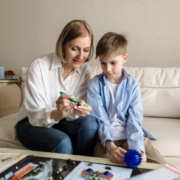Transforming Lives with In-Home ABA Therapy: A Personalized Approach to Autism Support
As autism spectrum disorder (ASD) diagnoses continue to rise, families seek effective, individualized interventions to support their children’s development. According to the CDC, approximately 1 in 31 children are identified with ASD. In response to this growing need, Behavior TLC offers a tailored solution: our In-Home ABA Therapy Program.
What Is In-Home ABA Therapy?
Applied Behavior Analysis (ABA) is a scientifically validated approach to understanding and improving behaviors. Our In-Home ABA Therapy Program brings this evidence-based treatment directly into your home, allowing for a comfortable and familiar setting where children can thrive.
This program is designed to address a wide range of developmental challenges, including:
- Enhancing communication skills
- Improving social interactions
- Developing daily living skills
- Reducing challenging behaviors
By integrating therapy into the child’s natural environment, we ensure that interventions are relevant and seamlessly incorporated into daily routines.
Why Choose In-Home ABA Therapy?
Opting for in-home therapy offers several distinct advantages:
1. Individualized Attention
Each therapy session is tailored to the child’s unique needs, ensuring a personalized approach that maximizes progress.
2. Family Involvement
Parents and caregivers play an integral role in the therapeutic process. Our program includes training and support to empower families to reinforce strategies at home.
3. Natural Environment Learning
Learning in a familiar setting promotes generalization of skills, making it easier for children to apply what they’ve learned in various contexts.
4. Convenience and Comfort
Receiving therapy at home eliminates the need for transportation and allows children to remain in a comfortable environment, reducing potential anxieties.
The Impact of ABA Therapy
Research consistently demonstrates the effectiveness of ABA therapy in improving outcomes for children with ASD. A study published in the Journal of Autism and Developmental Disorders found that children who received intensive ABA therapy showed significant improvements in IQ, language skills, and adaptive behavior CDC.
At Behavior TLC, our team of Board Certified Behavior Analysts (BCBAs) and trained therapists utilize data-driven methods to monitor progress and adjust interventions as needed, ensuring continuous growth and development.
Getting Started with Behavior TLC
Embarking on the journey of in-home ABA therapy begins with a comprehensive assessment. Our team collaborates with families to understand the child’s strengths, challenges, and goals. Based on this assessment, a customized therapy plan is developed and implemented.
We accept a variety of insurance plans and assist families in navigating the authorization process, making quality therapy accessible and manageable.
Hear from Our Families
“Behavior TLC has been a game-changer for our family. The therapists are compassionate, professional, and truly invested in our child’s success. We’ve seen remarkable progress in communication and social skills.” – A Parent of a Program Participant
“The in-home therapy model has been incredibly convenient for us. Our child is more engaged, and we feel supported every step of the way.” – A Parent of a Program Participant
Conclusion
At Behavior TLC, we are committed to providing high-quality, personalized ABA therapy that empowers children and supports families. Our In-Home ABA Therapy Program offers a flexible and effective solution for families seeking to make meaningful progress in their child’s development.
If you’re interested in learning more about our program or scheduling an assessment, please contact us today. Together, we can work towards a brighter future for your child.












